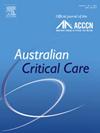A retrospective cohort study of Medical Emergency Team events amongst adult trauma patients
IF 2.7
3区 医学
Q2 CRITICAL CARE MEDICINE
引用次数: 0
Abstract
Background
The clinical associations of patient deterioration necessitating a Medical Emergency Team (MET) response have been studied in several types of hospital patient cohorts. However, there is limited information on MET events in the Australasian trauma population.
Methods
A retrospective patient cohort study was conducted through merger of the Royal Melbourne Hospital trauma and MET registries between July 1st, 2018, and December 31st, 2022. Data included patient demographics, MET events, selected trauma characteristics, and hospital survival. These data were summarised using standard descriptive statistics and univariable tables, along with a multivariable logistic regression model using hospital mortality as the dependent variable. Ethics approval was obtained (QA2022121) as per the institutional policy.
Results
There were 20 815 trauma admissions involving 20 111 individual patients. Overall, MET events occurred in 6% of admissions and were more common within major trauma patients. Overall, hospital mortality occurred in 2% of admissions, distributed as 7.1% major and 0.3% nonmajor trauma. Mortality for patients attended by at least one MET response was 5.9% overall but 9.0% in cases of major trauma. Within a multivariable logistic model accounting for clustered observations within individuals, MET events considered together were strongly associated with hospital mortality (odds ratio [OR]: 3.7 [95% confidence interval {CI}: 2.6–5.3]), as were advanced patient age (OR ≥ 24) and the presence of major trauma (OR: 11 [95% CI: 7.8–17]). MET events triggered by a systolic blood pressure <90 mmHg showed the strongest independent association with subsequent in-hospital mortality (OR: 7.5 [95% CI: 4.2–13]), whereas those triggered by heart rates >130 bpm showed the least association (OR: 1.4 [95% CI: 0.61–3.1]).
Conclusion
MET events occurred in 6% of adult trauma centre patients, more commonly in the presence of major trauma. While patient age and trauma severity were each strong independent predictors of hospital mortality, there was substantial heterogeneity in the clinical implications of MET events according to the type of underlying physiological disturbance.
成人创伤患者中医疗急救小组事件的回顾性队列研究
背景在几类医院患者队列中研究了患者病情恶化需要医疗急救小组(MET)响应的临床关联。方法在2018年7月1日至2022年12月31日期间,通过合并墨尔本皇家医院的创伤和MET登记处,开展了一项回顾性患者队列研究。数据包括患者人口统计学特征、MET事件、选定的创伤特征和住院存活率。这些数据通过标准描述性统计和单变量表格以及以医院死亡率为因变量的多变量逻辑回归模型进行汇总。根据机构政策,该研究获得了伦理批准(QA2022121)。总体而言,有 6% 的入院患者发生了 MET 事件,并且在重大创伤患者中更为常见。总体而言,2%的入院患者出现了住院死亡,其中7.1%为重大创伤患者,0.3%为非重大创伤患者。至少有一次 MET 响应的患者死亡率为 5.9%,而重大创伤患者的死亡率为 9.0%。在多变量逻辑模型中,考虑到个体内的聚类观察结果,MET事件与住院死亡率密切相关(几率比[OR]:3.7[95% 置信区间{CI}:2.6-5.3]),与高龄患者(OR ≥ 24)和重大创伤(OR:11 [95% CI:7.8-17])也密切相关。由收缩压 <90 mmHg 引发的 MET 事件与随后的院内死亡率的独立关联性最强(OR:7.5 [95% CI:4.2-13]),而由心率 <130 bpm 引发的 MET 事件与随后的院内死亡率的关联性最小(OR:1.4 [95% CI:0.61-3.1])。虽然患者年龄和创伤严重程度都是住院死亡率的有力独立预测因素,但根据潜在生理紊乱的类型,MET事件的临床影响存在很大的异质性。
本文章由计算机程序翻译,如有差异,请以英文原文为准。
求助全文
约1分钟内获得全文
求助全文
来源期刊

Australian Critical Care
NURSING-NURSING
CiteScore
4.90
自引率
9.10%
发文量
148
审稿时长
>12 weeks
期刊介绍:
Australian Critical Care is the official journal of the Australian College of Critical Care Nurses (ACCCN). It is a bi-monthly peer-reviewed journal, providing clinically relevant research, reviews and articles of interest to the critical care community. Australian Critical Care publishes peer-reviewed scholarly papers that report research findings, research-based reviews, discussion papers and commentaries which are of interest to an international readership of critical care practitioners, educators, administrators and researchers. Interprofessional articles are welcomed.
 求助内容:
求助内容: 应助结果提醒方式:
应助结果提醒方式:


